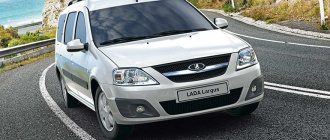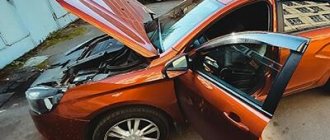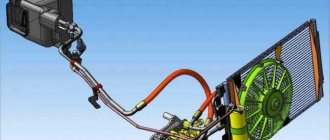For owners of Niva cars of all generations, fuel consumption remains one of the intractable problems.
An SUV with roots from the Soviet past has always had greater appetites than passenger models of similar dimensions. This is due to the all-wheel drive design, the need for additional costs to accelerate operating speeds in the transfer unit, cardan, front axle, and wheel assemblies.
In addition, the motor on the Travel series, despite the improvements, was developed back in the 70s of the last century, so it is inappropriate to demand modern performance from it.
Chevrolet Niva fuel consumption per 100 km, owner reviews
Fuel consumption is one of the most important indicators of a vehicle that influences the purchasing decision. Therefore, the technical documentation from the manufacturer always indicates this parameter, calculated in liters per 100 km. However, you must understand that the numbers on paper and actual consumption may differ. The practice of operating a car reveals deviations in various weather and road conditions, as well as with different driving styles.
If you do not go into the specifics of modifications, engine types and gasoline used, then the average fuel consumption on a Niva is:
- 9.9 l/100 km in mixed mode;
- 8.3 l/100 km on the highway;
- 12 l/100 km in the city.
Such data is obtained at the factory under standardized conditions, using special measuring equipment and relying on GOST standards. Therefore, these are the maximum average indicators that are not an operational norm. In practice, fuel consumption for a Niva may vary depending on many factors.
According to reviews from owners, the maximum real fuel consumption of the Niva can rise to 14-15 liters. It is also known that models with engines based on a carburetor system (not currently available) consume slightly more fuel than injection engines. Read how to reduce gasoline consumption in the final part of the article.
Ways to save fuel. Basic Rules
In Soviet times, advanced breeders chased SKF bearings as higher quality and more durable, trying to switch to imported ones whenever possible. What helps is that the car has a spacious interior. Sometimes it happens that if I load the car with 20 cases of beer and a couple more packs of soda, the car consumes an average of 12 liters of gasoline.
| Parameter | VAZ-2131 | VAZ-2123 Chevrolet Niva |
| Length, mm | 4240 | 4056 |
| Width, mm | 1680 | 1800 |
| Height, mm | 1640 | 1690 |
| Wheelbase, mm | 2700 | 2450 |
| Ground clearance, mm | 200 | 220 |
| Maximum speed, km/h | 137 | 140 |
| Acceleration time to 100 km/h, seconds | 19 | 19 |
| Curb weight, kg | 1425 | 1485 |
| Permissible total weight, kg | 1850 | 1860 |
What can we say about Taiga’s appetites – Reviews from car owners
| Niva - fuel consumption per 100 km Considering that at the end of 2015 the manufacturer switched to the production of power units adapted to the requirements of the Euro-5 standard, the indicators have changed. 5Jx16 ET48 Trunk volume mm 320 and 650 with rear seats folded Transmission type 5 manual transmission Final drive ratio 3.9 Suspension type front rear Independent on wishbones dependent on springs Curb weight kg 1485 Maximum speed km h 140 Acceleration time to 100 km h from 19 . |
| Fuel consumption Niva VAZ 2121, 2131 real reviews Lada Niva Travel 2022, clearly visible in the photo, is equipped with a combined suspension, where the rear is dependent on springs, and the front is independent on arms with a stabilizer bar and telescopic hydraulic shock absorbers. Basically, on the forums it is recommended to calculate consumption per car in such a way as to find out how much its maintenance costs per year, and not per month, as is usually done. |
- volume – 1.7 liters
- power – 80 hp
- torque - 127.5 Nm (at 4000 rpm)
- maximum speed – 140 km/h
- acceleration time to 100 km – 19 seconds
Is there an alternative? • It was with the VAZ-2121 that the history of the Niva began.
Chassis and braking system
The suspension design has been preserved since 1977, but despite the external similarities, the Niva Treval uses different balls, arms and other components. In addition, adjustable wheel bearings were removed from the chassis and non-adjustable ones with double-row races were installed. This improved the survivability of the hubs and made it possible to use wheels with a larger diameter.
Detailed Specifications:
| Front suspension | Independent, spring, multi-link |
| Rear suspension | Dependent, spring with continuous bridge |
| Front brakes | Disk |
| Rear brakes | Drums |
| Communication between transmission parts | CV joint |
All Niva Travel trim levels are equipped with an anti-lock braking system. Despite the outdated multi-piston calipers and aluminum drums at the rear, by modern standards the brakes on the Niva work perfectly and cope at any speed.
Comparison of equipment • Reviews from car owners
The standard equipment package includes 15-inch steel stampings, power steering, driver airbag, central locking, power and heated mirrors, plus power front windows. During suburban operation of cars, fuel consumption is up to 8.5 liters; in dense traffic inside a populated area, engines burn up to 14 liters, corresponding to their carburetor counterparts.
| Engine | Consumption (highway) | Consumption (city) | Consumption (mixed cycle) |
| VAZ Niva 2131 1.7 | — | — | 12 l/100 km |
| VAZ-2181 1.7 | 10.1 l/100 km | 12 l/100 km | 11.5 l/100 km |
From engine type • Main disadvantages
| Buy Lada Niva Travel 2020-2021 from an official dealer in Moscow |











